Switzerland › Railway lines
The Centovalli Railway - Swiss section
Locarno - Ribellasca
1000 mm
Locarno - Ribellasca
Ribellasca - Domodossola
Locarno
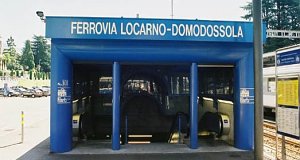
The entrance of the Centovalli Railway is located next to the tracks of Locarno SBB station
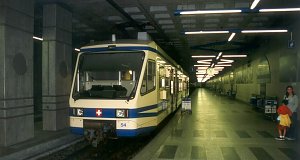
A class ABe 4/6 electric trainset is standing at the terminal
The 1000 mm gauge Centovalli Railway links the Swiss Locarno with Domodossola in Italy. The 52 km long line is of great importance in both the Swiss domestic and international traffic, offering the fastest connection between Ticino canton and West Switzerland (and the capital, Bern).
The Centovalli railway is operated by two companies: FART (Ferrovie Autolinee Regionali Ticinesi) on the Swiss side, and SSIF (Società subalpina di imprese ferroviarie) on the Italian side. Both companies share their tracks, rolling stock and personnel with each other. The Swiss section (Locarno-Camedo) is 19 km long, the rest is located in Italy. 10 pairs of international trains circulate on the line, with a journey time of 1 hour and 45 minutes. Apart from these, regional trains run in Locarno-Intagna and Locarno-Camedo relations in Switzerland, and between Re and Domodossola in Italy. The traffic is operated with class ABe 4/6 low-floor electric-trainsets acquired in 1992, with class ABe 6/6 and ABe 8/8 multiple units fron the 50's and 60's, and with the new panoramic trains of Ssif. The maximum speed allowed is 60 km/h.
The construction of the railway began in 1913. By that time, the Maggia Valley Railway already opreated between Locarno and Ponte Brolla (opened in 1907, closed in 1965), thus the construcion of the new line could be started in Ponte Brolla. The works stopped after 1 year due to financial difficulties and the outbreak of World War I. The construction works could be continued only in 1921 from two directions: from the Swiss and Italian ends. Both teams met in the spring of 1923 at Santa Maria Maggiore in Italy, and the railway line was inaugurated that year, on 25 November. The Centovalli railway is electrified from the beginning with 1200 V DC. They used steam locomotives only during the construction period. On the difficult mountainous terrain 34 tunnels and 83 bridges had to be built. The maximum altitude difference is 638 m. The lowest point of the railway is Locarno station on 196 m, which is the lowest train station is Switzerland, the line reaches its highest point in Santa Maria Maggiore on 836 m above sea level. At the beginning, the Centovalli Railway had a common terminus with the tram of Locarno (closed in 1960) and the Maggia Valley Railway on Piazza della Stazione in Locarno. The today's underground section between Locarno terminal and San Martino was built between 1983 and 1990. The 2791 m long tunnel has 2 stations, San Antonio and Solduno, apart from Locarno terminal. The first 1512 m long section (Locarno - San Antonio) was built using mining method, the rest (San Antonio - San Martino - Solduno) was excavated from the surface.
San Martino
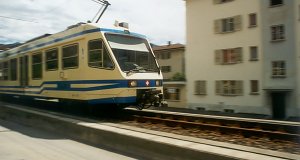
The train emerges from the tunnel after Solduno...
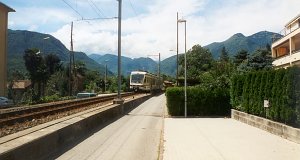
...and arrives immediately at San Martino station
Ponte Brolla
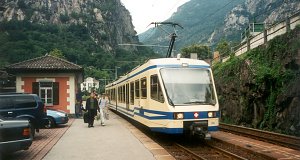
Arrival of a train, the electric trainset ABe 4/6 54, running to Locarno
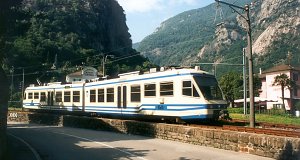
Today the branching track ends in an engine shed. From here, the Centovalli railway runs in the valley of the Melezza river.
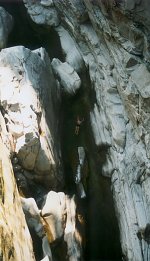
Somebody is swimming between the rocks
The station was named after the bridge situated at its northern end. Under the Ponte Brolla flows the Maggia river, which originates near the St. Gotthard tunnel, and enters Lago Maggiore between Ascona and Locarno. Around the station, the track runs in north-south direction, crossing the east-west flow of Maggia. After the bridge follows the junction of the former Locarno–Bignasco railway, a line mainly for freight traffic, closed in 1965. An interesting fact about this line was the laterally placed Oerlikon-system catenary.
Intragna
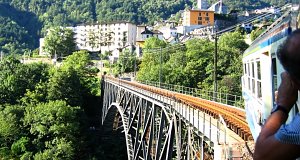
Crossing the Isorno viaduct. This steel viaduct is 75 m high and 128 m long.
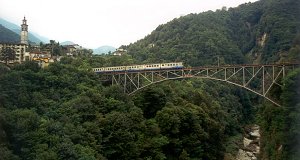
A train (ABe 8/8 with two cars) is crossing the Isorno-viaduct toward Locarno, near Intragna
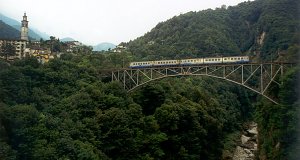
A train (ABe 8/8 with two cars) is crossing the Isorno-viaduct toward Locarno, near Intragna
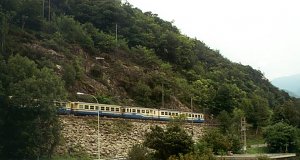
And proceeds toward Ponte Brolla
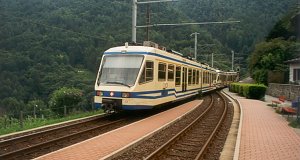
Intragna station
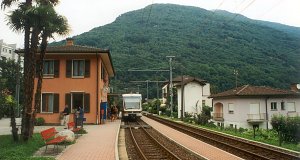
Intragna station
Camedo
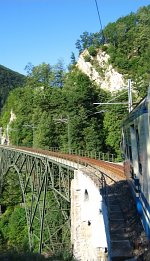
The Ruinacci viaduct from the train's window
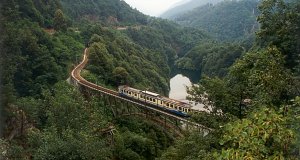
The Ruinacci viaduct near Camedo
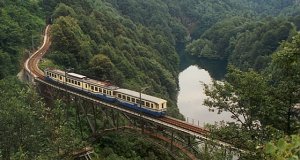
The Ruinacci viaduct near Camedo
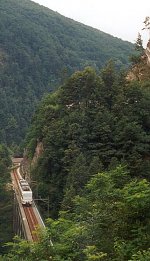
The Ruinacci viaduct near Camedo
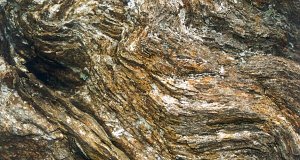
Rock at my photo location
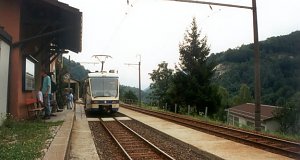
Camedo Station
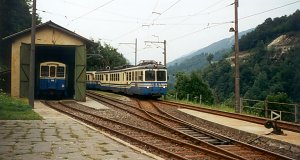
Camedo Station
Camedo is the last station before the Italian border. The border station is Ribellasca. After crossing the border, the valley changes name: Centovalli becomes Val Vigezzo. From here on, our train is called Vigezzina, instead of Centovallina. Moreover, the river becomes masculine. It is called now Melezzo.
Please, sign in to post a new comment!

